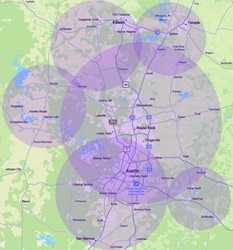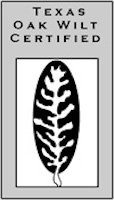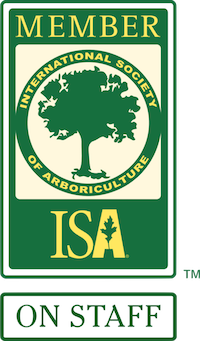Central Texas trees can be challenging when they decide to take a bit of a lean.
If you have a leaning tree on your property, it’s important to properly assess the danger it might pose, and take appropriate corrective measures.
Understanding Tree Leans
Many different things can cause a tree to start leaning. We need to understand why a tree is leaning before we can figure out how best to help it.
- Sweeps: Sweeping leans are a common sight in the Greater Austin area, where trees gradually self-correct their lean over time. They are often noticed years after the initial lean occurred and are generally structurally sound. Sweeps can result from trees reaching for sunlight.
- Bows: Bowed trees exhibit a unique arching shape, with their main stem starting vertically at the ground and then curving toward the horizontal. This phenomenon is frequently associated with the added weight of snow or ice, something we’ve become more familiar with the past few winters!
- Straight Leans: Straight leans are the most critical concern. They occur when a tree’s main stem begins to lean directly from the ground, causing the stem to deviate from its usual vertical position. These leans typically result from specific events that disrupt the tree’s structural integrity.
Helping Leaning Trees
When deciding how to best help a leaning tree, we take several things into account.
- Tree Size: In the greater Austin area, our landscape features a diverse array of tree sizes. Small trees or bushes that have been gently tipped and are loose in their planting area can often be successfully righted if their trunk remains intact and the situation is not expected to repeat. On the other hand, larger trees with substantial root balls and damaged roots may not be practical to return to an upright position and secure. Assessing the tree’s size can help determine the most appropriate approach.
- Cause of Lean: Understanding the underlying cause of the lean is key. If the tree was inadvertently knocked over by a vehicle or encountered accidental damage, the corrective process may be more straightforward. However, if the lean is a result of repeated animal damage or marks, additional steps, such as anchoring, staking, or protective fencing, may be necessary to prevent further incidents.
- Tree Resilience: Our native trees have the remarkable ability to bolster their structure by adding wood to counteract external forces. Healthy trees with ample resources can rebound and adapt to their new environment, potentially transforming a straight lean into a sweep. We often witness robust, well-buttressed trees as evidence of this natural resilience. However, trees that are either too weak or severely damaged may not recover, posing future risks.
Correcting a Leaning Tree
In Central Texas, we can often help a leaning tree! The first thing we do is determine whether the tree is safe. If it poses an imminent danger, a leaning tree needs to be removed before it falls, especially if it is close to a building, or an area where people might be injured.
Assessing a Leaning Tree
Central Texas soil compositions vary significantly, so assessing the soil is particularly important. An accurate assessment needs to extend below ground. We check the roots and the surrounding soil for stability.
If the root system is compromised or the soil lacks the capacity to hold it in place, anchoring the tree may not be effective.
Cracks in your soil around the base of the tree could mean it needs immediate attention. If you see large cracks in the soil around a leaning tree, please contact us.
Anchoring and Bracing a Leaning Tree
If a leaning tree is structurally stable, anchoring and bracing it can help it build strength. We support the tree, while creating new structural stress. This encourages the tree to add new wood, which improves its stability.
We Can Help Your Leaning Tree
Leaning trees can be dangerous. It’s important to understand the type of lean, its cause, the tree’s resilience, and the condition of the roots and soil. If you need help assessing a leaning tree, contact the professional arborists at A Good Morning Tree Service. We can help you assess your tree, and ensure the continued health and safety of your trees and property.
Free On-Site Estimates
7am – 7pm
7 days a week




